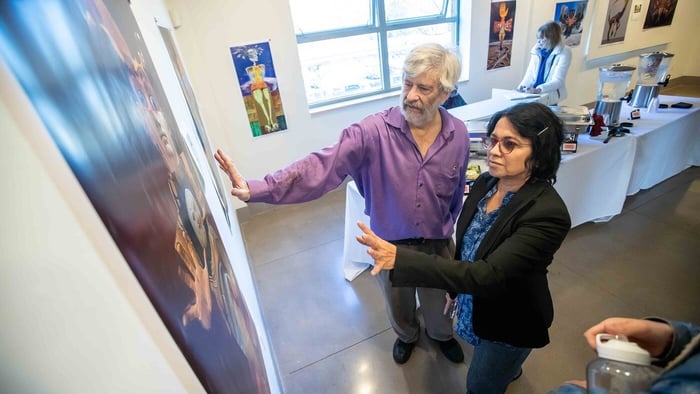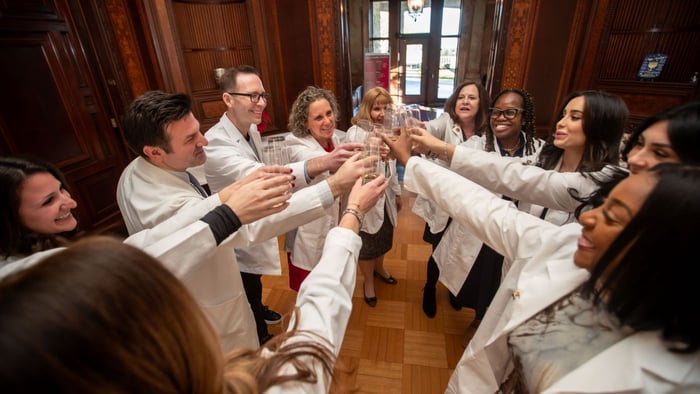Artist's Statement
I had a dream about a friend who was able to unzip his body and revealed a squirrel inside. He then reached into his fur and uncovered several different animals inside all with more zippers. I think of that dream often when I make my art.
Letter from the Curator Alkananda Mukerji
The Manhattanville Studio Art Department is pleased to present Tim Ross’ exhibition "These images came from my monotypes.”
Tim Ross, a New York and New Jersey-based painter, printmaker, and digital artist, offers incredible new work that manifests as an engaging statement of his dreams. The Exhibition opened on February 1, 2024, and runs until March 15, 2024, in the college’s Berger Art Gallery at the Berman Student Center.
Professor Ross remains current with the younger generations and technology, taking the time to teach himself Photoshop and the mindset behind digital platforms in the vital art forms. We can see this in his latest creative works in this Exhibition. All the images were created digitally. Tim has created hundreds of digital pieces, several of which have been exhibited in this series, called "These images came from my monotypes”.
The prints draw a thin line between his paintings, printmaking, and digital art. His artwork shows an uncommon sincerity and passion for making art every day. Tim says he creates his dreams in artworks ranging from flying elephants to strange aquatic creatures.
Everyone who knows Tim should not be surprised in the slightest that this is what he dreams about. Tim loves humor; he loves his puppets, toys, and illustration books. This endearing quality comes out very clearly in his
artwork. Many of his works depict faces, animals, water, sky, body parts, trees, and spaceships. These images are sometimes deformed, distorted, twisted, collaged, mangled, multilayered, monstrous, unnatural, surrealist,
peculiar, or just plain weird. These otherworldly qualities enhance the beauty of his work.
It is a testament to his creativity that he is always eager to experiment further. He does not want to limit himself to a single medium. One can almost feel his adventures in his dreams as if we are entering his labyrinthine of dreams themselves and participating in them.
Tim comes from an internationally known artist family. His parents, John Ross and Clare Romano, were well-known printmakers and educators. John Ross taught at Manhattanville for over 30 years. He designed the
college’s prestigious seal. The seal is still used as a symbol of the college on our certificates. Professor Clare Romano taught at the Pratt Institute.
Very early on in his academic career, Professor Ross co-wrote the second edition of “The Complete Printmaker” with his parents. This book details techniques, traditions, and innovations in the medium. The book
teaches step-by-step techniques of over 45 printmaking techniques, from traditional etching, engraving, lithography, screen printing, the relief print process, and tday’s digital prints.
Professor Ross is loved and adored by his students. He is a brilliant artist and a devoted teacher. Manhattanville and the Studio Art Department are grateful to have Professor Ross as an educator, friend, and colleague.
Please contact Professor Ross at [email protected] for any further inquiries.
Introduction by Randy Williams
"It is the business of mythology proper, and of the fairy tale, to reveal the specific dangers and techniques of the dark interior way from tragedy to comedy."
- Joseph Campbell “The Hero with A Thousand Faces”
Artmaking records our history and, in the process of doing so, creates a system of wonder and inquiry. By creating a system of inquiry, the artist creates a catalog of inexhaustible questions; these questions ensure the quality of the product through practice and process. This experience is visible in Tim Ross’ newest artwork. Tim Ross has an intuitive and intelligent approach to arranging collage elements on flat surfaces. His content reads like a cryptic myth. His formal structures are stately and well-proportioned, with a masterful application of color combinations. There is a graceful manipulation of the background and foreground that creates a seamless harmony. This is illustrated in “Green Wing Purple” 50” x 35 “2023. This attention to both content and form can be seen in his entire portfolio.
“Green Wing Purple”
Tim considers his selected images in his digital anthology carefully before using them; each image becomes an object for elevation. Like Robert Rauschenberg and Romare Bearden, Tim Ross has a meaningful and holistic approach to arranging collage elements. The magic of Tim’s artwork is its ability to create unique combinations. These visual combinations invite the viewers to see intimately and intensely. Tim has followed a long tradition of artists like Pablo Picasso, Kurt Schwitters, Max Ernst, Wangechi Mutu, Hannah Hoch, Robert Rauschenberg, and Romare Bearden. Like these artists, Tim has advanced storytelling. His artwork has an intense classification of arranged and rearranged images. His visual narratives are compelling. They are well-researched and brilliantly detailed. Tim’s artwork offers the viewers an opportunity to slow down and view the worlds of art constructed of both fact and fiction. Tim has merged art and technology to create an inclusive art form. He continues to use the “tried and true” tradition of collage-making to tell his endless stories. Unraveling the mysteries of the universe is just one of the challenges of the artist. Like a scientist, the artist employs critical reasoning to select and disentangle aesthetic problems. Tim examines the physical world by collecting images. Collecting quality images is an art form in and of itself. His knowledge of digital techniques helps to organize well-structured narratives.
Tim Ross is an astute student of history; he has an extensive knowledge of art history, mythology, and universal folktales. This wealth of information has helped him create a body of cutting-edge prints. His knowledge of traditional practices combined with new technologies has allowed him to create artwork that is current and unique. Tim has separated his body of artwork from the norm by fusing together conventional aesthetic elements with non-contemporary aesthetic elements. Tim has used his mastery of physical manipulation to aid with his use of digital manipulation. Tim Ross has created a thoughtful art style. His unrestricted view of visual information creates a powerful selection of ready-to-use images. Tim’s images are personal, iconic, historic, and pedestrian. His collection consists of his traditional drawings, prints, and paintings. Other images arrive at content from digital references and daily life. Tim Ross’ Artwork is cutting-edge contemporary yet wedded to traditional practice and physical manipulation of the visual elements. He is in step with art and the new technology.
Yet, by all accounts, Tim combines the familiar with the unfamiliar to create a new familiar. Tim is leading the way with his new artwork, and the history of art is always within reach as he looks over his shoulder.
Learn more about Manhattanville's Art Studio Program
About Manhattanville
We Are Valiant
Since 1841, Manhattanville College has provided a transformative educational experience. As a private liberal arts institution, Manhattanville roots its education in a rich history of academic excellence and innovative programs. With more than 55 undergraduate programs, 70 graduate programs, and a doctoral program, we empower every student to cultivate their intellectual curiosity, sharpen their critical thinking skills, and strive for a more just world.
Our History and Legacy
Since its origins as a Catholic boarding school to its present day as a non-denominational, co-ed private university, Manhattanville College has evolved to meet the needs of students who seek a more just world. A haven for independent thinking and socially conscious values, our interdisciplinary education is rooted in the liberal arts and experiential learning.
Founded in 1841 in New York City as a boarding school and parochial school for women, Manhattanville College has consistently strived to expand higher education to all sectors of society. Under the visionary leadership of President Grace Dammann, R.S.C.J., Manhattanville College voted to admit African-American students in 1938 and we have continuously worked to create a more inclusive student body. Today, over a third of our students identify as first-generation, and even more consider themselves BIPOC. We are also a designated Hispanic Serving Institution, a reflection of our increasingly diverse community.
We have also grown in other ways. When Manhattanville College officially took over the former estate of diplomat Whitelaw Reid in Westchester in 1952, we cemented our role in the educational development of the region. The U.S. News and World Report named us as the #1 private college for social mobility in New York. Students volunteer over 30,000 hours of community service through the Clark Center for Social Justice. The School of Education offers the highest number of programs and additional support through the Changing Suburbs Institute’s network of Professional Development Schools. Nursing candidates complete clinic hours in local organizations, providing patient-centered care to the area.
We are proof of how academic excellence, a commitment to social justice, and a global outlook can transform students and, by extension, society.
Location
Manhattanville College benefits from both the peaceful beauty of Westchester County and the vibrant, non-stop energy of New York City. The 100-acre campus provides a safe and comfortable environment where every student’s intellectual life can blossom with the unparalleled professional opportunities of a world-class city, only 30 miles away.
Reid Castle, a 19th-century architectural gem, anchors the campus and houses the Welcome Center, Admissions, Financial Aid, and several event spaces. Designed by famed Central Park architect Frederick Law Olmsted, the picturesque green quad hosts our academic buildings and centers, the college library, four performance facilities, and fifteen new or renovated science and nursing labs.
The campus also boasts two historic chapels. The architect Maya Lin restored one, Lady Chapel, to include a glass roof, located near the new Ohnell Environmental Center, a non-invasive structure that reflects Manhattanville College’s commitment to sustainability. Our newest building, the Richard A. Berman Student Center, received a LEED gold rating from the U.S. Green Building Council.
In addition to our four residence halls and dining hall, students enjoy amenities like a campus market and store and comprehensive athletic facilities, including a fitness center, tennis courts, an ice rink, a baseball and softball field, and an indoor turf facility.
We are a short car, train, or bus ride from New York and the city’s main airports. We are also easily accessible by car from anywhere in the TriState area and can also be reached via the Metro-North Railroad from NYC Grand Central Terminal or Westchester’s Bee-Line bus.




